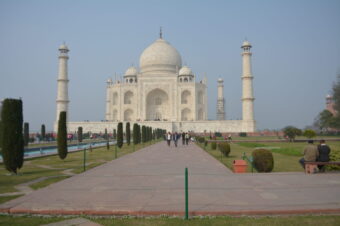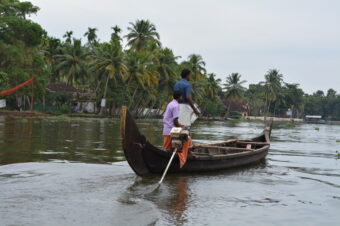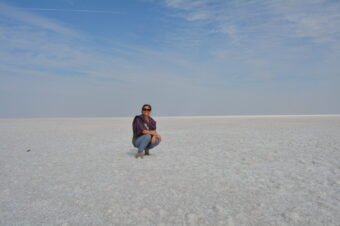Disclaimer: This post contains affiliate links. I will earn a commission if you make a purchase by clicking on the link at no extra cost to you.
Each year thousands, if not millions, of Hindu pilgrims make their way to the Holy City of Varanasi for the privilege of bathing in the sacred waters of the Ganges river to purify their souls. The iconic ghats (steps) along the Ganges river are some of the most photographed in India. The Holy City of Varanasi is where life returns to ashes.

I was really looking forward to visiting Varanasi. I was fascinated by its history dating back to the 11th century making it one of the oldest cities in India. I was mesmerized by the Ganges, a lifeline used for everything from transportation to bathing to daily chores to cremation.
I couldn't believe I was finally there! I expected to be blown away and instantly enchanted by this mystical city but it was a bit of a let down.
I'm not sure why.

Maybe because it was near the end of our trip so we were fed up of the touts and the cow dung (the narrow alleyways making it very difficult to avoid). Maybe it was because I thought the Holy City of Varanasi would be acceptably clean (sadly, the sacred Ganges is filthy).
Or maybe Varanasi just didn't live up to all the hype. But, I can say without a doubt that Varanasi is one of those places that has to be seen at least once because there really is no other place like it anywhere else in the world. Varanasi is its own entity within an already very complex country. It's a place of extreme extremes; it's a photographer's dream and a germophobe's nightmare (actually that would apply to most of India).
THE BURNING GHAT OF MANIKARNIKA
Varanasi is mostly known for its burning ghats (or cremation grounds) - the most popular being Manikarnika. Devoted Hindus believe that being cremated in the Holy City is the ultimate release into the much-anticipated state of nirvana. Varanasi is where life returns to ashes. Cremating the dead by the Ganges river has been going on for centuries and this peculiar ritual attracts curious visitors such as myself each year.
Strangely, I wasn't bothered by the dead bodies. Some bodies were barely wrapped in disheveled shrouds, others lovingly enveloped in fancier cloths the color of spices. Many of the defunct had garlands of marigold around their necks. I wasn't bothered either by the cremation process itself.
What I did find disturbing was how the dead were handled. After the bodies were immersed in the sacred Ganges, they were then carelessly (or so it seemed) piled one on top of the other awaiting to be cremated.
I understand that hundreds of bodies are cremated every day but I thought (with my Westernized concept of death) they would be handled with more respect. Maybe it wasn't considered disrespectful. From what I understood the cremation process is just a means to get to their final destination, divine nirvana, which holds, I'm guessing, more importance than death itself.

In this surreal context, it wasn't unusual to see charred arms or legs or feet left hanging, crisp and frail, completely disconnected from the bodies to eventually turn to ashes on their own. Lots of hungry, salivating emaciated stray dogs lurked around the cremation grounds sniffing around for left over bones. These human bones were relieved of all life and significance.
The piles of wood near the burning ghats are used for the cremations but not all the wood is of equal quality. Hindus with better means can afford the most expensive sandalwood; the other cheaper wood is for those with lesser means. Another interesting ritual is that the bodies are carried on a concocted wooden stretcher of sorts by Dalits for the last mile.
Only male members of the family are permitted to accompany the defunct. The men can be heard chanting as they make their way to the burning ghats; it's believed that women's cries are too loud and can potentially disturb the dead family member's journey to nirvana.
Dalits (or Untouchables) are the only ones allowed to cremate the bodies. In India's caste system, they are at the bottom of the list. Dalits are deemed impure and less than human. Though castes were legally abolished in 1949, this system continues to regulate the societal hierarchy in India.
DASHASHWAMEDH GHAT PUJA CEREMONY
A more appeasing experience was the puja (fire) ceremony held every night at the Dashashwamedh Ghat. The ceremony accompanied by chanting is a dedication to Lord Shiva, the Ganges river, the sun and fire - ultimately the whole universe. The ceremony lasts for about an hour - just enough time to give you a bit of a spiritual boost or to give you an up close look at how much religion is ingrained in India's society.
Hindus and foreigners alike are welcome to assist the ceremony. Bowls are passed around to collect donations but it's entirely up to you if you want to donate or not. It was somewhat of a surreal experience sitting there by Mother Ganga witnessing this centuries-old ritual which still takes place every night.

SADHUS: THE HOLY MEN OF INDIA
If you've never heard of those with painted faces called Sadhus then let me be the first to introduce you to the holy men (and some women) of India. Just like India, explaining Sadhus can be complex. In short, they're Hindus (usually yogis but not all) who renounced all worldly possessions and desires dedicating their entire lives to achieving moksha (liberation).
Sadhus, being holy men, rely on fellow Hindus' kindness and goodwill for everyday necessities such as food. They willingly choose to live in temples or on the streets - anywhere but in a conventional house. True-to-the-bone Sadhus do not resort to begging but posers do tend to crop up taking advantage of well-to-do tourists (beware).
There are different sects of Sadhus some of which choose to live completely naked (as the picture below clearly shows - you've been warned). Another characteristic in identifying Sadhus is that they cover their bodies with ashes from the cremation ground - a symbol of having detached themselves fully from the present world.
Many Sadhus believe that smoking cannabis brings them closer to Shiva, their god of choice. Though cannabis is illegal in India, they are exempt as this is part of their religious rituals.

After my short time in the Holy City of Varanasi, I can't straight out say I didn't like it. I enjoyed strolling along the ghats, getting lost in the labyrinth of narrow alleyways and seeing everyday life focused around the Ganges. But, I really wanted to fall under Varanasi's rumored hypnotic vibe and that just didn't happen.
However, I was left perplexed by the contradiction of so much death surrounded by so much life at the cremation ghats. I was also moved by the puja cermony where I was fascinated by such deep, raw devotion.
I think Varanasi is one of those places travelers either love or hate. I'm somewhere in the middle. Maybe, in its own cunning way, that's exactly where the Holy City of Varanasi wants to keep me.
READ MORE ON INDIA:
- A Celebration at the Border of India and Pakistan
- On Not Falling in Love With the Taj Mahal
- Introducing the Great Rann of Kutch of Gujarat
- The Slums of Dharavai: A Highlight of my Trip in India
- Cruising Along the Backwaters of Alleppey in Kerala
- Visiting Shri Karni Mata: The Rat Temple of Deshnoke
TRAVEL RESOURCES:
- Verify visa requirements for India on the official website
- Book flights to India via Skyscanner
- Compare hotel prices in India on Booking.com & Agoda
- Check hostel prices on HostelWorld
- Stay connected using an Airalo E-sim for India
- Search for tours & excursions in India
- Shop for affordable travel insurance with SafetWing
- Save on conversion fees while traveling with Wise
PIN THIS POST!










11 Responses
Visiting Shri Karni Mata: The Rat Temple of Deshnoke - Life Untraveled
[…] The Holy City of Varanasi: Where Life Returns to Ashes […]
Introducing the Great Rann of Kutch of Gujarat - Life Untraveled
[…] The Holy City of Varanasi: Where Life Returns to Ashes […]
Not Falling In Love With The Taj Mahal - Life Untraveled
[…] The Holy City of Varanasi: Where Life Returns to Ashes […]
A Celebration at the Border of India & Pakistan - Life Untraveled
[…] The Holy City of Varanasi: Where Life Returns to Ashes […]
Sacred Cows & Holy Crap of India - Life Untraveled
[…] The Holy City of Varanasi: Where Life Returns to Ashes […]
Ryan Biddulph
Super fascinating Lydia. The thing that got me about India was the real-ness of the place, which can get on your nerves sometimes because we are not used to a less sanitized, gritty, yep, sometimes filthy and dirty place. But then again, their is order in the chaos and an embracing of the cow crap, filthy water, folks peeing and pooping in public and all that stuff. India taught me how not to judge. Except when I was in an annoyed, judgmental mood LOL.
Lydia@Lifeuntraveled.com
Haha…..that’s the thing with India – it always successfully gets under peoples’ skin! I was much more tolerant than my boyfriend but I admit traveling through India was a challenge but I would go back anytime.
The Urge To Wander .
Beautiful post. My feelings towards Varanasi were ambivalent as well, even though I am Indian and Hindu. I too steer clear of offering money for photos, but that Sadhu would have been hard to resist 🙂
Lydia@Lifeuntraveled.com
Thank you so much! I’m really happy to hear the opinion of an actual Hindu – I really appreciate it! As travelers, we often quickly visit a place without really getting to know it. I didn’t want to appear like I had Varanasi figured out but I still wanted to express my true sentiments. I actually took the pic of that Sadhu for my mom…..lol! 😉
2TravelDads
I genuinely appreciate your take and observations from your western view. I haven’t been but it’s one of the cultural phenomena of the world that I do want to experience some day.
Lydia@Lifeuntraveled.com
Thank you so much! Sometimes it’s hard to put into words how we felt about a place especially somewhere as intriguing as Varanasi. Hope you and the boys get to experience it one day! 🙂